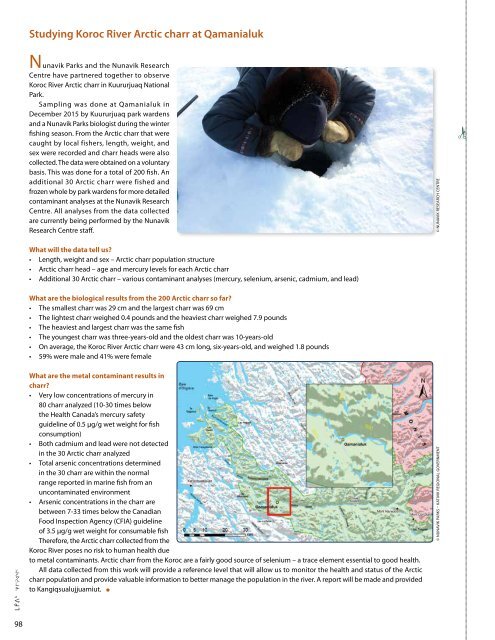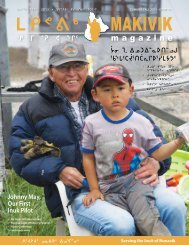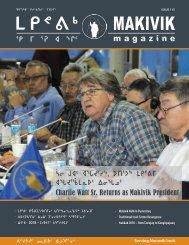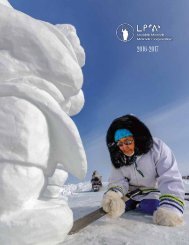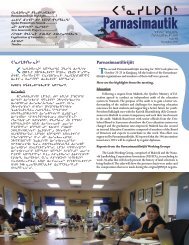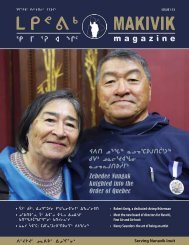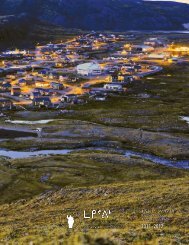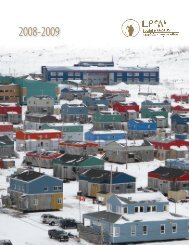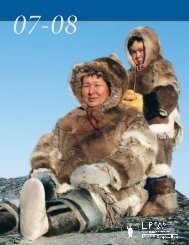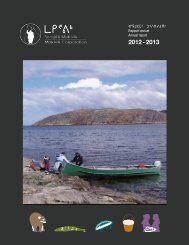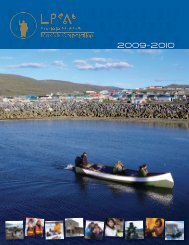Create successful ePaper yourself
Turn your PDF publications into a flip-book with our unique Google optimized e-Paper software.
Studying Koroc River Arctic charr at Qamanialuk<br />
ᒪᑭᕕᒃ ᕿᒥᕐᕈᐊᖏᑦ<br />
98<br />
Nunavik Parks and the Nunavik Research<br />
Centre have partnered together to observe<br />
Koroc River Arctic charr in Kuururjuaq National<br />
Park.<br />
Sampling was done at Qamanialuk in<br />
December 2015 by Kuururjuaq park wardens<br />
and a Nunavik Parks biologist during the winter<br />
fishing season. From the Arctic charr that were<br />
caught by local fishers, length, weight, and<br />
sex were recorded and charr heads were also<br />
collected. The data were obtained on a voluntary<br />
basis. This was done for a total of 200 fish. An<br />
additional 30 Arctic charr were fished and<br />
frozen whole by park wardens for more detailed<br />
contaminant analyses at the Nunavik Research<br />
Centre. All analyses from the data collected<br />
are currently being performed by the Nunavik<br />
Research Centre staff.<br />
What will the data tell us?<br />
• Length, weight and sex – Arctic charr population structure<br />
• Arctic charr head – age and mercury levels for each Arctic charr<br />
• Additional 30 Arctic charr – various contaminant analyses (mercury, selenium, arsenic, cadmium, and lead)<br />
What are the biological results from the 200 Arctic charr so far?<br />
• The smallest charr was 29 cm and the largest charr was 69 cm<br />
• The lightest charr weighed 0.4 pounds and the heaviest charr weighed 7.9 pounds<br />
• The heaviest and largest charr was the same fish<br />
• The youngest charr was three-years-old and the oldest charr was 10-years-old<br />
• On average, the Koroc River Arctic charr were 43 cm long, six-years-old, and weighed 1.8 pounds<br />
• 59% were male and 41% were female<br />
What are the metal contaminant results in<br />
charr?<br />
• Very low concentrations of mercury in<br />
80 charr analyzed (10-30 times below<br />
the Health Canada’s mercury safety<br />
guideline of 0.5 μg/g wet weight for fish<br />
consumption)<br />
• Both cadmium and lead were not detected<br />
in the 30 Arctic charr analyzed<br />
• Total arsenic concentrations determined<br />
in the 30 charr are within the normal<br />
range reported in marine fish from an<br />
uncontaminated environment<br />
• Arsenic concentrations in the charr are<br />
between 7-33 times below the Canadian<br />
Food Inspection Agency (CFIA) guideline<br />
of 3.5 μg/g wet weight for consumable fish<br />
Therefore, the Arctic charr collected from the<br />
Koroc River poses no risk to human health due<br />
to metal contaminants. Arctic charr from the Koroc are a fairly good source of selenium – a trace element essential to good health.<br />
All data collected from this work will provide a reference level that will allow us to monitor the health and status of the Arctic<br />
charr population and provide valuable information to better manage the population in the river. A report will be made and provided<br />
to Kangiqsualujjuamiut.<br />
© NUNAVIK PARKS – KATIVIK REGIONAL GOVERNMENT © NUNAVIK RESEARCH CENTRE


